Yamaha M7CL User Manual

M7CL Editor
Owner’s Manual
Special Notices |
Contents |
|
|
|
|
•The software and this owner’s manual are the exclusive copyrights of Yamaha Corporation.
•Copying of the software or reproduction of this manual in whole or in part by any means is expressly forbidden without the written consent of the manufacturer.
•Copying of the commercially available music sequence data and/or digital audio files is strictly prohibited except for your personal use.
•Yamaha makes no representations or warranties with regard to the use of the software and documentation and cannot be held responsible for the results of the use of this manual and the software.
•The screen displays as illustrated in this owner’s manual are for instructional purposes, and may appear somewhat different from the screens which appear on your computer.
•Future upgrades of application and system software and any changes in specifications and functions will be announced separately.
•The company names and product names in this Owner’s Manual are the trademarks or registered trademarks of their respective companies.
Yamaha Pro Audio Global Site
http://www.yamahaproaudio.com/
Getting Started ......................................... |
2 |
Master window ......................................... |
9 |
Overview window ................................... |
11 |
Selected Channel window....................... |
23 |
Library window ....................................... |
42 |
Patch Editor window............................... |
45 |
Rack window ........................................... |
49 |
Meter window ......................................... |
58 |
Group/Link window ................................ |
60 |
Scene window ......................................... |
64 |
Keyboard Shortcuts................................. |
71 |
Index........................................................ |
72 |
*Specifications and descriptions in this owner ’s manual are for information purposes only. Yamaha Corp. reserves the right to change or modify products or specifications at any time without prior notice.
1 |
M7CL Editor Owner’s Manual |

Getting Started
Overview of M7CL Editor
M7CL Editor enables you to remotely control the Yamaha M7CL mixing console and to save the parameter settings on your computer. To use M7CL Editor, you must first perform the following operations:
1Start and configure Studio Manager.
2Start and configure M7CL Editor.
3Synchronize M7CL Editor with your M7CL console ( p.8).
NOTE For more information on using Studio Manager, refer to the Studio Manager Owner’s Manual.
Configuring M7CL Editor
You must configure the following settings for each open Editor.
NOTE • Before you make the following settings, you must make settings for the DME-N Network Driver and select the MIDI port in the Setup window of Studio Manager.
•To open an editor, double-click the icon for the desired editor in the Studio Manager window.
System Setup
To open the System Setup window, choose [System Setup] from the [File] menu.
NOTE Be sure to specify the Input port and Output port.
AInput port/Output port
From the ports you specified in Studio Manager, select the ports that the editor will use to communicate with the M7CL console.
BFast Sync
This allows synchronization to be speed up, reducing the time required. Use this check box to choose whether to enable this function.
CWindow Control from Console
This option determines whether or not using the USER DEFINED KEYS on the console enables you to remotely open and close the M7CL Editor windows.
DLevel Meter
1

2
3
4
5
6
By disabling the meter function you can reduce the processing load caused by screen drawing and communication. This option specifies whether the level meter functionality will be enabled.
EConfirmation
These check boxes specify whether a confirmation dialog box will appear when you store (Store Confirmation), recall (Recall Confirmation), patch (Patch Confirmation), or make a patch change that would modify an existing patch (Steal Patch Confirmation).
FAdministrator Password
Enter the Administrator password that was specified on the M7CL console. If this password is not entered correctly, it will not be possible to synchronize from M7CL Editor to the M7CL console.
2 |
M7CL Editor Owner’s Manual |

Mixer Setup
To open the Mixer Setup window, choose [Mixer Setup] from the [File] menu.
1
2
3
AInput Channels
Specify the number of input channels on the M7CL console. When the editor is synchronized with the M7CL console, the actual number of channels on the M7CL console will automatically be specified here.
BMix Bus Setup
Here you can make settings relating to the MIX buses.
Signal Type: Choose either MONOx2 or STEREO for each two adjacent odd-numbered/even-numbered MIX buses.
Bus Type/Send Point: Choose either VARI (PRE FADER) or VARI (PRE EQ) or FIXED for each two adjacent odd-numbered/even-numbered MIX buses.
Pan Link: This is valid only if the Signal Type is set to STEREO and the Bus Type is set to VARI. If this is enabled, the pan setting sent to stereo MIX buses will be linked with the pan setting to the STEREO bus.
CMatrix Bus Setup
Here you can make settings relating to the MATRIX buses.
Signal Type: Choose either MONOx2 or STEREO for each two adjacent odd-numbered/even-numbered MATRIX buses.
Bus Type/Send Point: Choose either PRE FADER or PRE EQ for each two adjacent odd-numbered/even- numbered MATRIX buses.
Pan Link: This is valid only if the Signal Type is set to STEREO and the Bus Type is set to VARI. If this is enabled, the pan setting sent to stereo MATRIX buses will be linked with the pan setting to the STEREO bus.
3 |
M7CL Editor Owner’s Manual |

Creating a user key
To open the Create User Key window, choose [Create User Key] from the [File] menu.
This creates a user key (with “.M7U” file name extension) that can be read from a USB storage device by the M7CL console to automatically set user-specific parameters.
1 3 |
2 |
4 |
5 |
6 |
7
8
9
J
K
O P
AUser Name
Specify the name of the user. You can enter up to eight single-byte characters of alphabet and numerals.
L
M
N
BComment
Enter a comment for each user. You can enter up to thirty-two single-byte alphanumeric characters.
CPassword
Enter a password that will be used when this user key is read by the M7CL console. You can enter up to eight sin- gle-byte alphanumeric characters. Uppercase and lowercase are distinguished.
DRe-Enter Password
Enter the password once again as a safeguard against mistaken entry.
EPOWER USER
Specify whether this user is a power user. Power users can use the M7CL console to create or edit a user authentication key with a specified user level.
FAdministrator Password
Enter the Administrator password that was specified on the M7CL console. This is not required if no Administrator password has been specified on the M7CL console, but if this password is incorrect you will be asked to enter it when the user key is read.
GACCESS PERMISSION
In this area, specify the parameters that this user will be allowed to operate.
4 |
M7CL Editor Owner’s Manual |
HCH OPERATION
INPUT, ST IN, DCA, MIX, MATRIX, ST/MONO: Select the channels whose parameters will be operable.
HA: Change the operating privileges for the head amp gain and phantom power of the selected channels. PROCESSING: Change the operating privileges for overall signal processing parameters (except for fader and [ON] key) of the selected channel. For the specific parameters included in PROCESSING, refer to the appendix of the M7CL owner’s manual.
FADER/ON: Change the operating privileges for the pan/balance, fader, channel on, send on/off, and send level of the selected channels.
Set All: Turn on HA, PROCESSING, and FADER/ON for all channels. Clear All: Turn off HA, PROCESSING, and FADER/ON for all channels.
Set by One Click: If this button is on, HA, PROCESSING, and FADER/ON will all be turned on when you select a channel. If all are already on, all will be turned off.
ISCENE LIST
STORE/SORT: Change the operating privileges for scene store and sort operations. RECALL: Change the operating privileges for scene recall operations.
JLIBRARY LIST
STORE/CLEAR: Change the operating privileges for library store and clear operations. RECALL: Change the operating privileges for library recall operations.
KFILE LOAD
USER SETUP: Change the operating privileges for loading user-defined keys and preferences when loading a file.
SYSTEM SETUP MONITOR SETUP: Change the operating privileges for loading system setup and monitor setup settings when loading a file.
CURRENT SCENE: Change the operating privileges for loading the current scene when loading a file. SCENE LIST: Change the operating privileges for loading the scene list when loading a file. LIBRARY LIST: Change the operating privileges for loading the library list when loading a file.
LCURRENT SCENE
INPUT PATCH: Change the operating privileges for input patch operations. INPUT NAME: Change the privileges for editing the input names. OUTPUT PATCH: Change the operating privileges for output patching. OUTPUT NAME: Change the privileges for editing the output names. BUS SETUP: Change the operating privileges for buses.
RACK: Change the operating privileges for rack operations.
MUTE GROUP ASSIGN: Change the privileges for assigning mute groups.
MUTE GROUP MASTER: Change the operating privileges for enabling/disabling mute groups.
MMONITOR SETUP
OSILLATOR: Change the operating privileges for oscillator settings.
TALKBACK: Change the operating privileges for talkback settings.
NSYSTEM SETUP
MIXER SETUP: Change the privileges for making mixer setup settings.
OUTPORT SETUP: Change the privileges for making outport setup settings.
MIDI: Change the privileges for making MIDI settings.
OCreate
Creates the user key.
PCancel
Closes the window.
5 |
M7CL Editor Owner’s Manual |

Working with Sessions
All of your console’s mix settings in M7CL Editor, including Scene and library data, are called Sessions. The following table describes how to handle Sessions.
Creating a new Session |
Choose [New Session] from the [File] menu. |
|
|
Opening a previously saved Session |
Choose [Open Session] from the [File] menu. |
|
|
Saving the current Session |
Choose [Save Session] from the [File] menu. |
|
|
Saving the current Session with a new name |
Choose [Save Session As...] from the [File] menu. |
|
|
When you save a session in the window of an editor, the settings of only that editor will be saved in a file. Session files saved by M7CL Editor have a filename extension of “.YSE”. Files in which only the M7CL console data is saved (filename extension “.M7C”) can also be handled, allowing you to use a USB storage device to exchange data with the M7CL console.
If you save a Session in the Studio Manager window, all selected Editor settings are saved in a file with a file extension of “.YSM.”
Undo/Redo Function
In M7CL Editor, you can cancel the latest operation (Undo) and also cancel the cancellation of the latest operation (Redo). If you perform an Undo operation twice in a row, you can cancel the two most-recent operations. If you perform an Undo operation three times in a row, you can cancel the three most-recent operations. In this way, you can cancel multiple recent operations. The following table describes how to use the Undo/Redo function.
Undo |
Choose [Undo] from the [Edit] menu. |
|
|
Redo |
Choose [Redo] from the [Edit] menu. |
|
|
Please note, however, that after you perform one of the following operations, you cannot successfully undo or redo any previous operation:
•Operations on the M7CL console
•Quitting Studio Manager
•Synchronizing with the M7CL console
•Session operations
NOTE You cannot Undo or Redo the following operations:
•Edits in the Setup window
•Synchronization
•Opening and closing the windows
•Resizing or moving the windows
There are certain other operations that cannot be undone, depending on the function.
NOTE For library or scene operations, Undo/Redo applies only to the single most recent operation. You cannot undo any operations prior to this. Undo/Redo in these windows is available only using the [UNDO] button within the respective window. Even if you perform a scene recall from the Master window, you cannot use a shortcut or menu operation to undo the recall.
6 |
M7CL Editor Owner’s Manual |

Window operations
You can select and open each window from the [Windows] menu. For the INPUT CH window and Effect Editor window, use the sub-menu to select the channels or library you want to see.
You can choose Tile or Cascade to arrange the windows within the editor.
● Tile |
● Cascade |
In the Library window or Scene window, click the tabs located at the top of the window to switch between pages.
7 |
M7CL Editor Owner’s Manual |

Synchronizing M7CL Editor
When M7CL Editor starts up, the parameter settings on the console and the parameter settings in M7CL Editor may be different. Therefore, you must first match the parameter settings on the console with those in M7CL Editor. This operation is called “synchronization.” Follow the steps below to synchronize M7CL Editor.
1Select [Synchronize], then [Re-synchronize].
The following window opens.
2Select whether you want to transfer your settings to M7CL Editor, or vice versa.
At this time, the All Libs option determines whether or not Scene and Library data is synchronized.
PC Console: Transfers the current parameter settings in M7CL Editor to your console. Console PC: Transfers the current parameter settings of your console to the M7CL Editor.
3Click [OK].
Do not operate the console while synchronization is in progress.
NOTE If you use the “Total Recall” function in Studio Manager, all selected Editors in Studio Manager are synchronized with the corresponding devices.
Offline Edit Function
If you do not want to synchronize your console with M7CL Editor, select [Offline Edit] from the [Synchronization] menu. To apply your off-line edits to your console, select [Re-Synchronize] from the [Synchronization] with the PC -> Console option to synchronize the console with M7CL Editor.
The Offline Edit function is also activated when you click the [ONLINE]/[OFFLINE] button in the Sync window.
NOTE Some effect parameters in the console change their displayed values depending on the sampling frequency. If you switch M7CL Editor from OFFLINE to ONLINE, displayed parameter values may change because M7CL Editor loads the sampling frequency from the console and updates the display.
Other Functions
Resetting to the default value (Ctrl+click)
Move the cursor to a control or a parameter value, then hold down the <Ctrl> key and click the mouse button to reset the value to the default (e.g., to reset a pan setting to Center).
However, the channel faders and the send knobs and bar graphs can be set to –∞ regardless of the default value.
Ctrl+Shift+Click
Move the mouse cursor to a channel fader or to a send knob or bar graph, and click while holding down the <Ctrl> key and <Shift> key to set the nominal value regardless of the default value.
8 |
M7CL Editor Owner’s Manual |
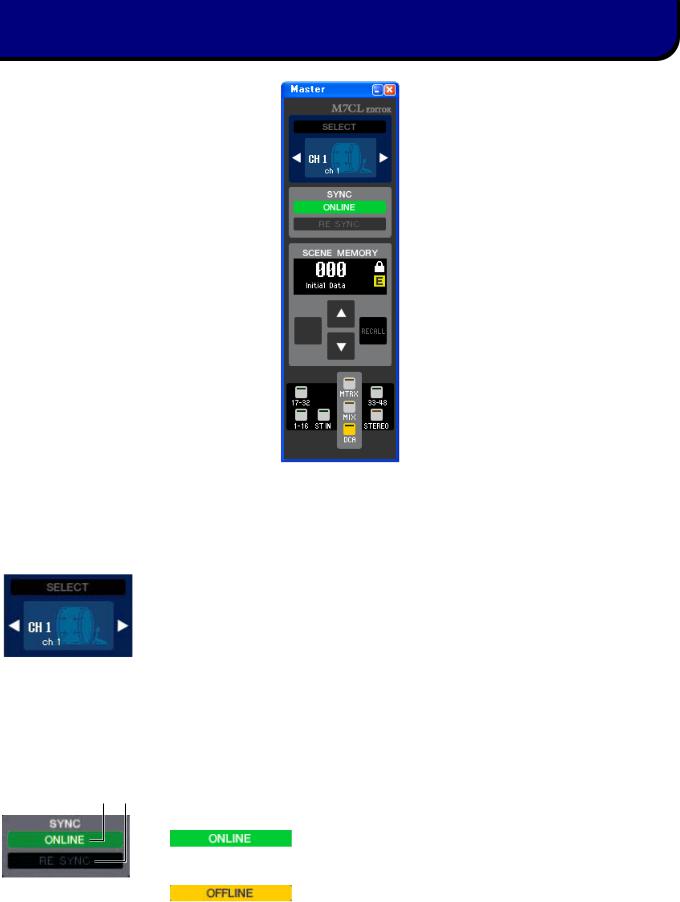
Master window
In the Master window you can synchronize to the M7CL itself, recall scenes, and display the Overview window. To open this window, choose [Master] from the [Windows] menu.
CHANNEL SELECT
This indicates the number and name of the channel to which your operations will apply. To switch channels, you can either click the [SELECT] button and choose from the list that appears, or you can click the left/right arrow-shaped channel select buttons. You can also use the channel name text box to edit the name.
This is linked with the [SEL] keys on the M7CL itself. You can right-click the icon to select a different one.
SYNC
This indicates the status of connection and synchronization between M7CL Editor and the M7CL.
A[ONLINE]/[OFFLINE] button
1 2 The ONLINE/OFFLINE status will alternate each time you click this button. This has the same function as [Synchronization] menu [Offline Edit]. ( p.8)
This indicator is shown when M7CL Editor is correctly connected to the M7CL itself. In this state, the parameters of M7LC Editor and the M7CL itself are linked.
This indicator is shown when M7CL Editor and the M7CL itself are not connected, or when there is a problem with the connection, or when Offline Edit is selected. In this state, the parameters of M7CL Editor and the M7CL itself are not linked.
B[RE-SYNC] button
Clicking this button opens the Synchronization dialog box.
This has the same function as [Synchronization] menu [Re-Synchronize]. ( p.8)
9 |
M7CL Editor Owner’s Manual |

SCENE MEMORY
|
|
Here you can view the currently-recalled scene, and recall or store scenes. |
|
|
AScene number display |
1 |
|
Indicates the number of the scene that is selected for store or recall. |
|
||
2 |
|
|
3 |
BProtect indicator |
|
The lock icon is displayed for scene memories that are protected.
4CEdit indicator
5The edit indicator will light when you edit the parameters after recalling a scene.
6D[STORE] button
This button stores the current scene into the number shown by the scene number display (1).
E[▲]/[▼] buttons
These buttons increment or decrement the number shown in the scene number display (1). The scene number display (1) will blink until you actually store or recall, and while blinking will not match the scene number indicated on the M7CL.
F[RECALL] button
This button recalls the scene of the number shown in the scene number display (1).
Navigation Keys
These keys open various windows.
NOTE These are not linked with the navigation key section on the panel of the M7CL itself.
1
2
3
4
6 7 8
5
A[17-32] button
Opens the INPUT CH 17–32 window.
B[1-16] button
Opens the INPUT CH 1–16 window.
C[ST IN] button
Opens the ST IN window.
D[DCA] button
Opens the DCA window.
E[STEREO] button
Opens the STEREO/MONO window.
F[MIX] button
Opens the MIX window.
G[MTRX] button
Opens the MATRIX window.
H[33-48] button
Opens the INPUT CH 33–48 window. This is available only during offline editing and when 48 is selected as the number of input channels in the Mixer Setup window, or when editing online with the M7CL-48.
10 |
M7CL Editor Owner’s Manual |
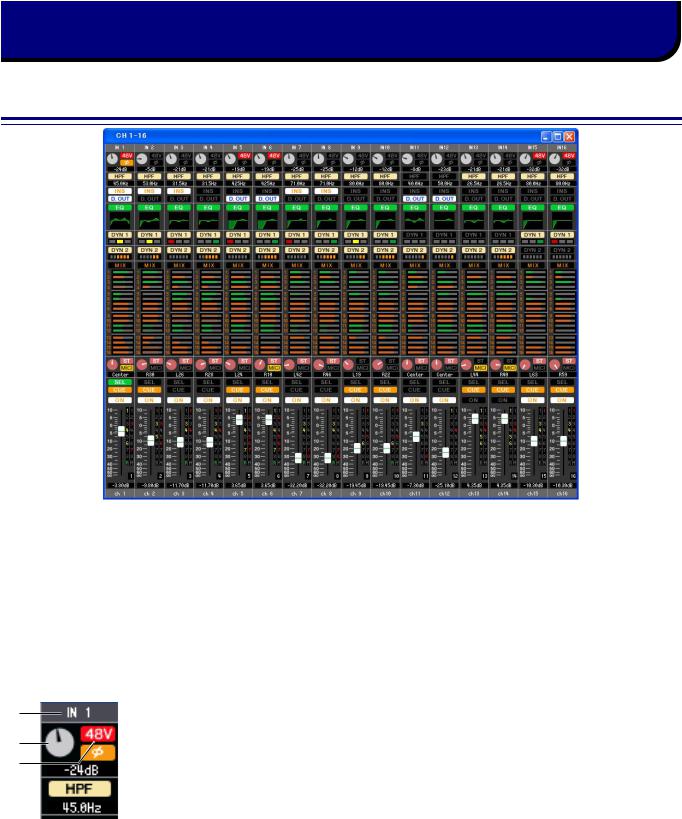
Overview window
INPUT CH window
This window displays the mix parameters of INPUT CH 1–16, 17–32, or 33–48(*). The parameters shown in the window can be selected from the [View] menu or the menu that appears when you right-click in the window.
You can access this window in the following ways.
●From the [Windows] menu, choose [Overview] and select “CH1-16” / “CH17-32” / “CH33-48”(*)
●Use the navigation keys in the Master window to turn on the [1-16] button / [17-32] button / [33-48] button(*)
●On the M7CL itself, assign one of the USER DEFINED KEYS to [1-16]/[17-32]/[33-48](*) in [INPUT CH] of [M7CL EDITOR CONTROL], and execute the function
(*) INPUT CH 33-48 can be viewed only if 48 is selected in the Input Channels field of the Mixer Setup window when editing offline, or when editing online with the M7CL-48.
1
2
3
AInput patch
Click here to select the input source that will be assigned to the INPUT CH, from the following choices.
NONE |
No assignment |
|
|
|
|
IN1–IN48(*) |
INPUT jacks 1–48(*) |
|
STIN1L–STIN4R |
L/R channels of ST IN jacks 1–4 |
|
|
|
|
SLOT1-1, SLOT1-2...SLOT3-15, SLOT3-16 |
Input channels of an I/O card installed in slots |
|
1–3 |
||
|
||
|
|
|
RACK1A, RACK1B...RACK8R(B) |
L/R outputs of Rack 1–8 |
|
|
|
(*)AD33–48 (INPUT jacks 33-48) can be viewed only if 48 is selected in the Input Channels field of the Mixer Setup window when editing offline, or when editing online with the M7CL-48.
BHA GAIN
Drag the knob in the screen to adjust the gain of the internal head amp or of the external head amp (AD8HR) patched to the INPUT CH.
C48V
Switches on/off the phantom power (+48V) of the internal head amp or of the external head amp (AD8HR) patched to the INPUT CH.
11 |
M7CL Editor Owner’s Manual |
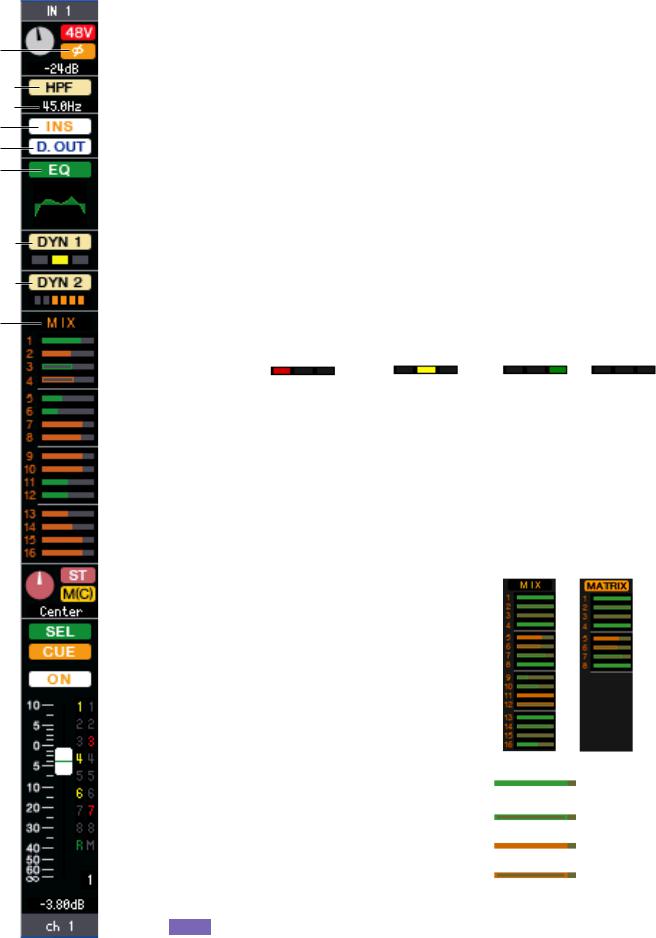
4
5
6
7
8
9

J
DØ (Phase)
Inverts the phase of the signal after AD conversion.
EHPF (High Pass Filter)
Switches the high pass filter on/off. You can drag the numeric value up or down to edit the cutoff frequency.
FINS (Insert)
Enables/disables the insert-in.
GD. OUT (Direct out)
Enables/disables the direct output.
HEQ (Equalizer)
Switches the EQ on/off. The graph immediately below the button shows the approximate response of the EQ. You can drag within the graph to edit the response of the EQ. To reset the EQ to flat response, hold down the <Ctrl> key of your computer keyboard and click the grap (The HPF setting will remain).
IDYN1/DYN2 (Dynamics 1/Dynamics 2)
Turns the two dynamics processors on/off.
If Gate is assigned (Dynamics 1 only), the status of the gate is shown immediately below the button.
Gate status |
|
|
|
|
|
indication |
|
|
|
|
|
|
|
|
|
|
|
On/off status |
On |
On |
On |
Off |
|
|
|
|
|
|
|
Open/closed |
Closed |
Open |
Open |
— |
|
status |
|||||
|
|
|
|
||
|
|
|
|
|
|
Remarks |
Gain reduction amount |
Gain reduction |
Gain reduction |
— |
|
is 30 dB or more |
amount is 0–30 dB |
amount is 0 dB |
|||
|
|
||||
|
|
|
|
|
If something other than Gate is assigned, a GR meter is shown immediately below the button, and the amount of gain reduction is shown while this is on.
The type for each dynamics processor can be selected in the Selected Channel window.
JMIX/MATRIX SEND
Switches between the send indications to MIX buses 1–16 and to MATRIX buses 1–8.
The bar graphs located immediately below the button show the send level of the signals sent from the INPUT CH to VARI type MIX/MATRIX buses. You can also drag the bar graph to left or right to set the send level. While you drag the bar graph, the send level is shown in the numerical display area for PAN/TO STEREO MONO (K).
You can set the minimum value (–∞ dB) by holding down the <Ctrl> key of your computer keyboard and clicking the bar graph, or set the nominal value
(0.00 dB) by holding down the <Ctrl> key and <Shift> key and clicking the bar graph.
The bar graph display will change according to the send position (pre/post) and on/off status of the signal sent from the INPUT CH to the MIX/MATRIX buses. To switch a send on/off, click the channel number located at the left of the bar graph.
•Pre/on (green)
•Pre/off (green)
•Post/on (yellow)
•Post/off (yellow)
NOTE For FIXED-type MIX buses, the bar graph is fixed at nominal level (0 dB), and only the on/off status is shown.
12 |
M7CL Editor Owner’s Manual |

|
|
|
|
|
|
|
|
KPAN/TO STEREO MONO |
|
|
|
|
|
|
|
|
|
|
|
|
|
|
|
|
|
The PAN knob adjusts the panning of the signal that is sent from the INPUT CH to the |
K |
|
|
|
|
|
STEREO bus L/R channels (or the L/C/R channels). You can set this to the center value |
||
|
|
|
||||||
|
|
|
|
|
|
|
|
by holding down the <Ctrl> key of your computer keyboard and clicking this knob. |
L |
|
|
|
|
|
|
The [ST] button is an on/off switch for the signal that is sent from the INPUT CH to |
|
|
|
|
|
|
|
the STEREO bus. |
||
M |
|
|
|
|
|
|
||
|
|
|
|
|
|
The [M(C)] button is an on/off switch for the signal that is sent from the INPUT CH to |
||
|
|
|
|
|
|
|
|
|
N |
|
|
|
|
|
|
the MONO bus. |
|
|
|
|
|
|||||
|
|
|
|
|
|
|
|
If LCR MODE is selected in the Selected Channel window, the [LCR] button will appear |
|
|
|
|
|
|
|
|
instead of the [ST] button and [M(C)] button, and the [LCR] button will be an on/off |
|
|
|
|
|
|
|
|
switch for the signal that is sent from the INPUT CH to the LCR bus. |
O |
|
|
|
|
|
|
LSEL (Select) |
|
|
|
|
|
|
|
Selects the INPUT CH for which you want to perform operations. This is linked with |
||
|
|
|
|
|
|
|||
|
|
|
|
|
|
|
|
|
|
|
|
|
|
|
|
|
the INPUT section [SEL] keys on the M7CL’s panel. |
|
|
|
|
|
|
|
|
MCUE |
|
|
|
|
|
|
|
|
This button cue-monitors the signal of the INPUT CH. This is linked with the INPUT |
|
|
|
|
|
|
|
|
section [CUE] keys on the M7CL’s panel. |
|
|
|
|
|
|
|
|
NON |
P |
|
|
|
Switches the INPUT CH on/off. This is linked with the INPUT section [ON] keys on |
||||
Q |
|
|
|
|
|
|
the M7CL’s panel. |
|
|
|
|
|
|
|
OFader |
||
|
|
|
|
|
|
|||
|
|
|
|
|
|
|
|
|
|
|
|
|
|
|
|
|
Adjusts the input level of the INPUT CH. When the M7CL itself is in other than SENDS |
|
|
|
|
|
|
|
|
ON FADER mode, this is linked with the INPUT section faders of the M7CL’s panel. |
|
|
|
|
|
|
|
|
The current fader value is shown in the numerical box located immediately below the |
|
|
|
|
|
|
|
|
fader. |
|
|
|
|
|
|
|
|
You can set this to the minimum value (–∞ dB) by holding down the <Ctrl> key of |
|
|
|
|
|
|
|
|
your computer keyboard and clicking the fader knob, or set it to the nominal value |
|
|
|
|
|
|
|
|
(0.00 dB) by holding down the <Ctrl> key and <Shift> key and clicking the fader knob. |
The numbers and alphabetical letters at the right of the fader indicate the DCA group and mute groups to which that channel belongs, and show the Recall Safe and Mute Safe status of the channel.
PChannel number
The numbers of DCA groups to which this channel belongs are shown in yellow.
 The numbers of mute groups to which this channel belongs are shown in red.
The numbers of mute groups to which this channel belongs are shown in red.
If this channel is set to Recall Safe, the R character is shown in green.
 If this channel is set to Mute Safe, the M character is shown in green.
If this channel is set to Mute Safe, the M character is shown in green.
This is the number of the INPUT CH. You can open the Selected Channel window for this channel by double-clicking this number. If you hold down the <Ctrl> key of your computer keyboard and double-click this, the Selected Channel window will open as an additional view.
QChannel name
This is a text box that displays the channel name. You can also edit the channel name in this text box.
13 |
M7CL Editor Owner’s Manual |

ST IN window
In this window you can view and edit the mix parameters of ST IN channels 1–4. The parameters shown in the window can be selected from the [View] menu or the menu that appears when you right-click in the window.
You can access this window in the following ways.
●From the [Windows] menu, choose [Overview] and then choose “ST IN”
●Use the navigation keys in the Master window to turn on the [ST IN] button
1
2
3
4

5
6
AINPUT PATCH
Selects the input source that will be assigned to the ST IN channel. The input sources that can be assigned are the same as for an INPUT CH ( p.11).
BHA GAIN
Drag the knob in the screen to adjust the gain of the internal head amp or of the external head amp (AD8HR) patched to the ST IN channel.
C48V
Switches on/off the phantom power (+48V) of the internal head amp or of the external head amp (AD8HR) patched to the ST IN channel.
DØ (Phase)
Inverts the phase of the signal after AD conversion.
EHPF (High Pass Filter)
Switches the high pass filter on/off. You can drag the numeric value up or down to edit the cutoff frequency.
FEQ (Equalizer)
Switches the EQ on/off (the L/R settings are linked). This is the same as the equalizer for INPUT CH ( p.12).
14 |
M7CL Editor Owner’s Manual |

GDYN1/DYN2 (Dynamics 1//Dynamics 2)
7
8
These buttons switch the two dynamics processors on/off. This is the same as the dynamics 1/dynamics 2 for INPUT CH ( p.12).
HMIX/MATRIX SEND
Switches between the send indications to MIX buses 1–16 or to MATRIX buses 1–8. This is the same as the mix/matrix send for INPUT CH ( p.12).
IBALANCE
The BALANCE knob adjusts the balance of the signal that is sent from the ST IN channel to the STEREO bus L/R channels (or the L/C/R channels). Other than the BALANCE knob, this is the same as PAN/TO STEREO MONO for an INPUT channel
( p.13).
JSEL (Select)
9 |
|
|
|
Selects the ST IN channel for which you want to perform operations. (L and R can be |
|
|
|
selected separately.) This is linked with the ST IN section [SEL] keys on the M7CL’s |
|
|
|
|
||
|
|
|
|
|
J |
|
|
panel. |
|
|
||||
KKCUE
LThis button cue-monitors the signal of the ST IN channel (L/R are linked). This is
linked with the ST IN section [CUE] keys on the M7CL’s panel.
M |
|
|
LON |
|
|
|
|||
|
|
|
|
|
|
|
|
|
Switches the ST IN channel on/off (the L/R settings are linked). This is linked with the |
|
|
|
|
ST IN section CH [ON] keys on the M7CL’s panel. |
|
|
|
|
MFader |
N |
|
|
Adjusts the input level of the ST IN channel. When the M7CL itself is in other than |
|
|
|
SENDS ON FADER mode, this is linked with the INPUT section faders of the M7CL’s |
||
|
|
|
|
|
O |
|
|
|
panel. |
|
|
|
||
|
|
|
|
The current fader value is shown in the numerical box located immediately below the |
|
|
|
|
fader. This is the same as the fader for INPUT CH ( p.13). |
|
|
|
|
NChannel number |
|
|
|
|
This is the number of the ST IN channel. You can double-click this number to open the |
|
|
|
|
Selected Channel window for this channel. If you hold down the <Ctrl> key of your |
|
|
|
|
computer keyboard and double-click this, the Selected Channel window will open as an |
|
|
|
|
additional view. |
|
|
|
|
OChannel name |
|
|
|
|
This is a text box that displays the channel name. You can also edit the channel name in |
|
|
|
|
this text box. |
15 |
M7CL Editor Owner’s Manual |
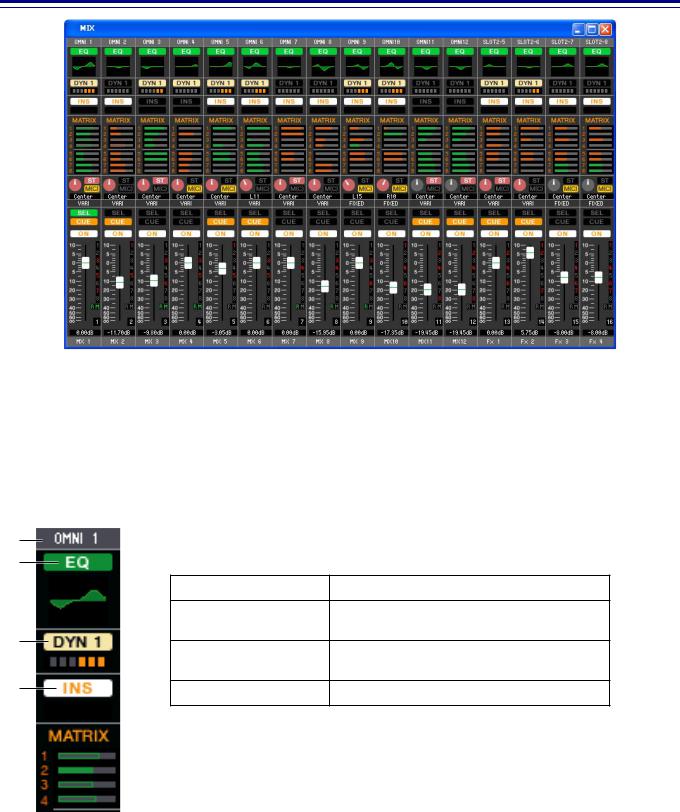
MIX window
In this window you can view and edit the parameters of MIX channels 1–16. The parameters shown in the window can be selected from the [View] menu or the menu that appears when you right-click in the window.
You can access this window in the following ways.
●From the [Windows] menu, choose [Overview] and then choose “MIX”
●Use the navigation keys in the Master window to turn on the [MIX] button
1
2
3
4
AOUTPUT PATCH
Click here to select the output port that will be assigned to the MIX channel, from the following choices.
OMNI1–OMNI16 |
OMNI jacks 1–16 |
SLOT1-1,
Input channels of an I/O card installed in slot 1–3
SLOT1-2...SLOT3-16
RACK1A,
L/R outputs of Rack 1–8
RACK1B...RACK8R(B)
2TROUT L, 2TROUT R L/R channels of the 2TR OUT DIGITAL jack
If multiple patches have been made, only the first port is shown.
If you change the patching in this window, the port that had been assigned until then will be cancelled, and only the newly selected port will be assigned.
BEQ (Equalizer)
Switches the EQ on/off. This is the same as the equalizer for INPUT CH ( p.12).
CDYN1(Dynamics 1)
Switches the dynamics processor on/off. This is the same as the dynamics 2 for INPUT CH ( p.12).
DINS (Insert)
Enables/disables the insert-in.
16 |
M7CL Editor Owner’s Manual |
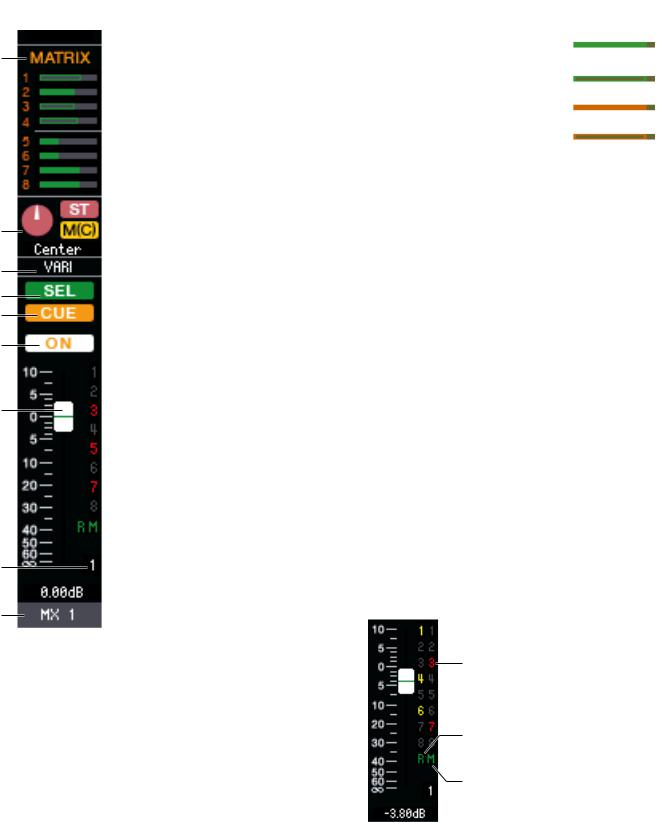
5
6
7
8
9
J
K
L
M
EMATRIX SEND
These bar graphs indicate the send levels of the signals sent from the
MIX channel to MATRIX 1–8 bus. You can also adjust the send levels by dragging a bar graph to left or right. While you drag the bar
graph, the send level is shown in the numerical display area for TO STEREO/MONO.
You can set the minimum value (–∞ dB) by holding down the <Ctrl> key of your computer keyboard and clicking the bar graph,
or set the nominal value (0.00 dB) by holding down the <Ctrl> key and <Shift> key and clicking the bar graph.
The bar graph display will change as follows according to the send position (pre/post) and on/off status of the signal sent from the MIX channel to the MATRIX buses.
To switch a send on/off, click the channel number located at the left of the bar graph.
FPAN/BALANCE
The PAN knob adjusts the panning of the signal that is sent from the mix channel to the STEREO bus L/R channels (or the L/C/R channels). You can set this to the center value by holding down the <Ctrl> key of your computer keyboard and clicking this knob. If assigned as a stereo bus, this adjusts the balance of the odd-numbered channel and even-numbered channel. The stereo bus setting can be made in Mix Bus Setup of the Mixer Setup screen.
The [ST] button is an on/off switch for the signal that is sent from the mix channel to the STEREO bus.
The [MONO] button is an on/off switch for the signal that is sent from the mix channel to the MONO bus.
If LCR MODE is selected in the Selected Channel window, the [LCR] button will appear instead of the [ST] button and [MONO] button, and the [LCR] button will be an on/off switch for the signal that is sent from the mix channel to the LCR bus.
GVARI/FIXED
Indicates the type (VARI or FIXED) of the currently selected MIX bus. This parameter can be switched in Mix Bus Setup of the Mixer Setup screen.
HSEL (Select)
Selects the MIX channel for which you want to make settings.
ICUE
This button cue-monitors the signal of the MIX channel.
JON
Switches the MIX channel on/off.
KFader
Adjusts the output level of the MIX channel. The current fader value is shown in the numeric box immediately below the fader. You can set this to the minimum value (–∞ dB) by holding down the <Ctrl> key of your computer keyboard and clicking the fader knob,
or set it to the nominal value (0.00 dB) by holding down the
<Ctrl> key and <Shift> key and clicking the fader knob.
The numbers and alphabetical letters at the right of the fader indicate the mute groups to which that channel belongs, and show the Recall Safe and Mute Safe status of the channel.
LChannel number
Indicates the number of the MIX channel. You can double-click this number to open the Selected Channel window for this channel. If you hold down the <Ctrl> key of your computer keyboard and double-click this, the Selected Channel window will open as an additional view.
MChannel name
This is a text box that displays the channel name. You can also edit the channel name in this text box.
17 |
M7CL Editor Owner’s Manual |
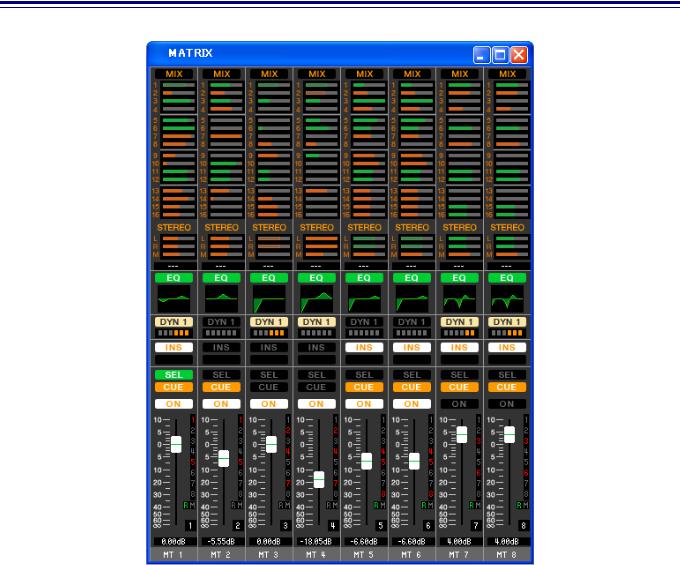
MATRIX window
In this window you can view and edit the parameters of MATRIX channels 1–8. The parameters shown in the window can be selected from the [View] menu or the menu that appears when you right-click in the window.
You can access this window in the following ways.
●From the [Windows] menu, choose [Overview] and then choose “MATRIX”
●Use the navigation keys in the Master window to turn on the [MTRX] button
18 |
M7CL Editor Owner’s Manual |

1AMIX/CH/ST IN (Send levels from the MIX/INPUT CH/ST IN to the MATRIX bus)
This switches between indicating the sends from MIX channels 1–16, the sends from INPUT CH 1–16 / 17–32 / 33–48 (*), and the sends from ST IN.
|
|
|
The bar graphs located immediately below the button indicate/adjust the level of the |
|
|
|
signal that is sent from each channel to the MATRIX bus. The method of operation and |
|
|
|
|
2 |
|
|
the meaning of the display are the same as for (5) MATRIX in the MIX window |
|
|
( p.17). |
|
|
|
||
|
|
|
|
|
|
|
(*) INPUT CH 33–48 can be viewed only if 48 is selected in the Input Channels field of the Mixer Setup |
|
|
|
window when editing offline, or when editing online with the M7CL-48. |
3BSTEREO (Send levels from the STEREO channels to the MATRIX bus)
Here you can view and edit the send levels of the signals sent from the STEREO channels to the MATRIX bus. While you drag the bar graph, the send level is shown in the numerical display area immediately below. The method of operation and the meaning
4of the display are the same as for (5) MATRIX in the MIX window ( p.17).
|
|
CEQ (Equalizer) |
5 |
|
Switches the EQ on/off. The graph immediately below the button shows the approxi- |
|
||
|
|
mate response of the EQ. This is the same as the equalizer for INPUT CH ( p.12). |
6DDYN1(Dynamics 1)
7Switches the dynamics processor on/off. This is the same as the dynamics 2 for INPUT CH ( p.12).
8EINS (Insert)
Enables/disables the insert-in.
|
|
|
FSEL (Select) |
9 |
|
|
Selects the MATRIX channel for which you want to make settings. |
|
|
||
|
|
|
GCUE |
|
|
|
This button cue-monitors the signal of the MATRIX channel. |
|
|
|
HON |
|
|
|
This switches the MATRIX channel on/off. |
|
|
|
IFader |
|
|
|
This adjusts the output level of the MATRIX channel. The current fader value is shown |
J |
|
|
in the numeric box immediately below the fader. |
|
|
The numbers and alphabetical letters at the right of the fader indicate the mute groups |
|
|
|
|
|
|
|
|
to which that channel belongs, and show the Recall Safe and Mute Safe status of the |
|
|
|
channel. (For the significance of the numbers and alphabetical letters, see p.13). |
|
|
|
JChannel number |
|
|
|
Indicates the number of the MATRIX channel. You can double-click this number to |
|
|
|
open the Selected Channel window for this channel. If you hold down the <Ctrl> key of |
|
|
|
your computer keyboard and double-click this, the Selected Channel window will open |
|
|
|
as an additional view. |
19 |
M7CL Editor Owner’s Manual |

STEREO/MONO window
In this window you can view and edit the parameters of the STEREO and MONO channels. The parameters shown in the window can be selected from the [View] menu or the menu that appears when you right-click in the window.
You can access this window in the following ways.
●From the [Windows] menu, choose [Overview] and then choose “STEREO/MONO”
●Use the navigation keys in the Master window to turn on the [STEREO] button
1 |
|
AEQ (Equalizer) |
|
Switches the EQ on/off (the L/R settings are linked). This is the same as the equalizer for |
|
|
||
|
|
|
|
|
INPUT CH ( p.12). |
2BDYN1(Dynamics 1)
3Switches the dynamics processor on/off. This is the same as the dynamics 2 for INPUT CH ( p.12).
4CINS (Insert)
Enables/disables the insert-in. (The L/R settings are linked.)
DMATRIX SEND
Here you can view and edit the send levels of the signals sent from the STEREO/MONO channel to MATRIX 1–8 bus. The method of operation and the meaning of the display are the same as for MATRIX in the MIX window ( p.17).
20 |
M7CL Editor Owner’s Manual |
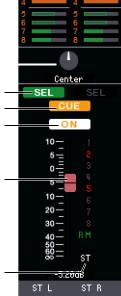
 EBALANCE
EBALANCE
Adjusts the left/right balance of the STEREO channel.
5 |
|
FSEL (Select) |
|
6
7
8
Selects the channel for which you want to make settings. (You can specify L and R independently.) This is linked with the STEREO/MONO MASTER section [SEL] keys on the M7CL’s panel.
GCUE
|
This button cue-monitors the signal of the STEREO/MONO channel. This is linked |
9 |
with the STEREO/MONO MASTER section [CUE] keys on the M7CL’s panel. |
HON
This switches the STEREO/MONO channel on/off. This is linked with the STEREO/ MONO MASTER section [ON] keys on the M7CL’s panel.
J |
IFader |
Adjusts the output level of the STEREO/MONO channel. This is linked with the STEREO/MONO MASTER section faders of the M7CL’s panel.
The current fader value is shown in the numeric box immediately below the fader. The numbers and alphabetical letters at the right of the fader indicate the mute groups to which that channel belongs, and show the Recall Safe and Mute Safe status of the channel. (For the significance of the numbers and alphabetical letters, see p.15).
JChannel number
This is the channel number (ST or M). You can double-click this number to open the Selected Channel window for this channel. If you hold down the <Ctrl> key of your computer keyboard and double-click this, the Selected Channel window will open as an additional view.
21 |
M7CL Editor Owner’s Manual |
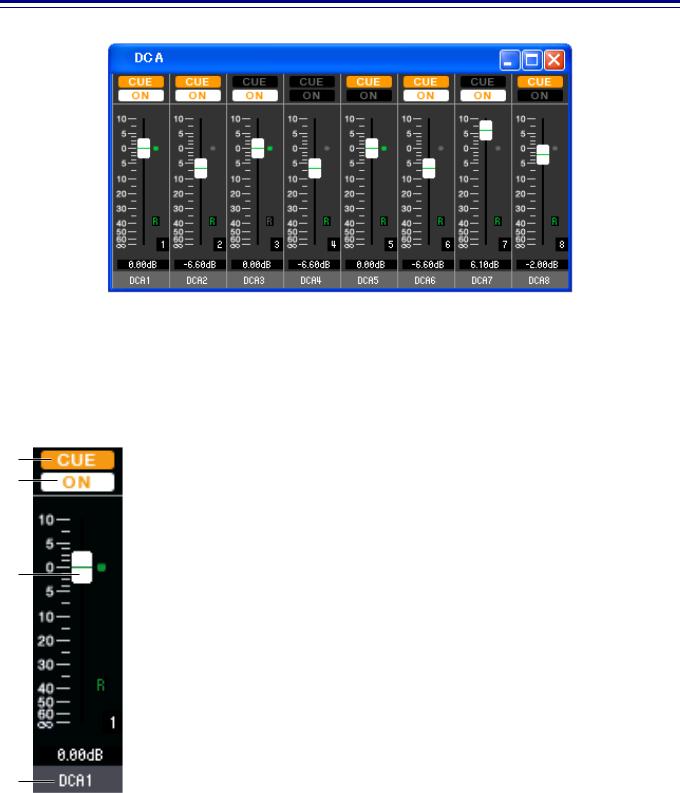
DCA window
In this window you can view and edit the parameters of DCA groups 1–8.
You can access this window in the following ways.
●From the [Windows] menu, choose [Overview] and then choose “DCA”
●Use the navigation keys in the Master window to turn on the [DCA] button
1
2
3
4
5
ACUE
This button cue-monitors all channels that are assigned to the DCA group.
BON
If you turn this on, all channels assigned to the DCA group will be turned on. If you turn this off, no signal will be output from the channels assigned to the DCA group.
CDCA fader
This fader adjusts the level of the DCA group.
The current fader value is shown in the numeric box immediately below the fader. You can set this to the minimum value (–∞ dB) by holding down the <Ctrl> key of your computer keyboard and clicking the fader knob, or set it to the nominal value (0.00 dB) by holding down the <Ctrl> key and <Shift> key and clicking the fader knob. If the fader is at nominal level, the green indicator at the right of the fader will light.
If a DCA group is set to Recall Safe, the R character at the lower right of the fader is displayed in green.
DDCA number
This is the number of the DCA group.
EDCA group name
This is a text box that displays the DCA group name. You can also edit the DCA group name in this text box.
22 |
M7CL Editor Owner’s Manual |
